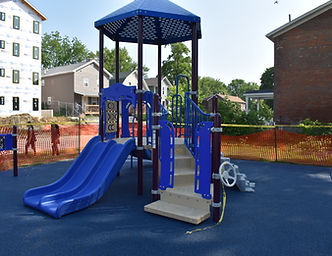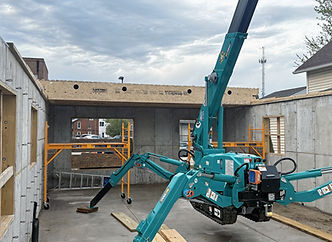
Housing Projects
Collaboratively expanding the supply of workforce housing in Muscatine County through tools such as 3D Home Printing - being one of the first in the state to utilize this proven, innovative technology.


Pictured above: Cast-in-place technology at Arbor Commons.
Housing Goals
Adopted by the Muscatine County Housing Council
Encourage development by expanding funding sources and partnerships.
Support opportunities to obtain and sustain affordable ownership.
Increase the inventory of quality affordable units.
Preserve long-term affordability and physical condition of the existing stock of housing.
Increase housing and associated supportive services for people with special needs.

Pictured above: 3D home printing at Arbor Commons.
Rural Housing Project
The Community Foundation of Greater Muscatine is prototyping cutting-edge housing methods to compare completion time, cost, and energy efficiency.
Building methods are planned to initially incorporate four concrete-based technologies: 3D printing, insulated cast-poured concrete forms (ICF), cast-in-place, and cement-board composite. These methods offer anticipated cost decreases, speed-to-market increases, extended lives, and extreme weather resistance, reducing utility costs, maintenance, and waste.
Using these varied alternative technologies on the homes’ exterior envelopes, four mid-market homes in the Arbor Commons neighborhood and six homes subsidized through grants in the Ignite Vitality: Mulberry revitalization area are targeted for construction.

Pictured above: Rendering of home using cast-in-place technology.
Interested in the Rural Housing Project?
To learn more about the Rural Housing Project, visit www.opensourceruralhousinginnovation.org or contact Ron Monahan at the Community Foundation of Greater Muscatine at rmonahan@givinggreater.org or 563-264-3863.

Ignite Vitality: Mulberry Project
Through this multifaceted pilot project, the Community Foundation and collaborative partners aim to maximize quality housing, strengthen neighborhood identity, support businesses, improve infrastructure, and provide family stabilization, amplifying opportunities for Muscatine residents in the area.
Components of the project include:
-
Grants for homeowners and businesses for façade improvements
-
New pocket park
-
Lighting, sidewalk, and crosswalk improvements
-
New home construction
-
Lead/hazard abatement opportunities
-
Connections to community resources
Exterior Housing Improvement Grants
A key part of the Ignite Vitality: Mulberry project is grants for home exterior improvements. Eligible homes must be: 1) within the neighborhood boundaries, 2) owned by the resident, and 3) under a certain income threshold.
A Project Manager—Mike Plank—will guide eligible homeowners through every step of the grant process.
Learn more about the Ignite Vitality: Mulberry project at www.ignitevitalitymulberry.org.

The neighborhood is two blocks from downtown and has the highest density of school-age children in Muscatine. It includes over 170 homes, various commercial properties, and Jefferson Elementary School.


3D Printing Videos


Pictured above: Building homes using cast-in-place technology.
Housing Information
The housing stock is the largest single capital investment and collective community asset. There is currently a supply-side failure that is having cascading effects on the community. Currently 11,000 people drive into Muscatine County to work each day, including 25% of our district educators. Rural areas often attract fewer developers, so local partners have joined together to support this priority innovatively and collaboratively.